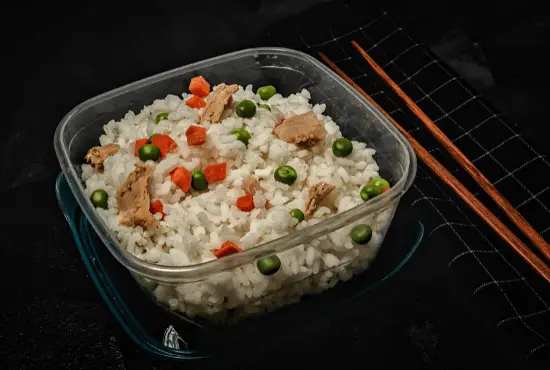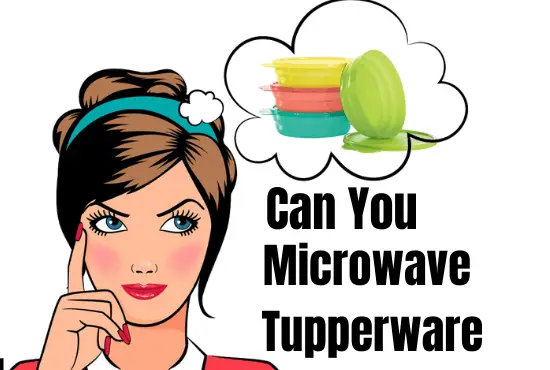Tupperware has always been a time saver when reheating and cooking food in the microwave. But due to its connection with the Plastic line, the consumers inquire about its safety. And whether you can microwave Tupperware or not?
Microwaving Tupperware designed with high-tech features is considered microwave-safe. Always use Tupperware having a steam-vent lid. It is to help escape the steam and prevent the build-up of extra pressure. When microwaving food, continuously stir the food between intervals of 3 minutes. The safe temperature for a heating process is up to 120°C along with the low or medium power limit.
Since 2010, Plasticware brands have been introducing newly designed Tupperware into the market. It is to make sure these products give up to the mark microwaving performance.
Here is detailed information about Tupperware Containers and how to microwave these products within a proper set-up.
Table of Contents
Is It Safe To Microwave Tupperware?
Although the Tupperware Containers carry Plastics, they are made BPA and dioxin-free. Thus, all Tupperware products are microwave-safe and follow the Food and Drug Administration (FDA) safety guidelines.
Most importantly, Tupperware manufacturers ensure to test their products’ microwave safety before releasing them to the market. The Containers have specially designed features to withstand extreme environments. They can also handle the required temperature within a short time of the heating process.
It is suggested to search for the microwave directions on the Tupperware products. It will help you understand its limitations and how you can microwave the specific Tupperware correctly.
How To Tell If Tupperware Is Microwave-safe?
The best way to recognize microwave-safe Tupperware is through the manual guide about the plastics that it contains.
Use the Tupperware product that has no traces of harmful plastics. So you ensure they do not melt or leach chemicals into the food. Thus, Tupperware is 100% microwaveable.
Another effective way to find the microwave safety of Tupperware is through the symbol. Look for the three squiggly lines at the bottom of the Container to know if it’s microwave-safe. These symbols may vary, either indicating a dish or microwave under radiation waves.
So, any Tupperware Product that does not show microwave-safe symbols must not be used in the microwave and storing of foods.
Types Of Microwave-safe Tupperware:
Make sure to buy Tupperware that matches your desired heating purpose. Here is a list of the best microwavable Tupperware products used for various heating tasks.
- Warmie Tup
- CrystalWave
- Microwave Rice/Omelette/Pasta maker
- MicroCook
- MicroGourmet
- Micro Fast Cooker
- Tupperware Ultra Pro
All these Tupperware Containers are designed to retain the delicious flavors, vitamins, and minerals inside the meal. Cooking and reheating healthy foods inside these products is considered safe and ideal.
How To Microwave Tupperware?

To ensure the Tupperware Container lasts longer and reheat your food perfectly, do practice the following basic steps.
- When preparing food, cut the food into small pieces and place it in Tupperware evenly. It will help consume less time for heating and making the product last longer. Always add sauces and syrups at the last few minutes of reheating as they require less heat.
- Microwaving Tupperware with its lid on the top saves you from all the splatters and spots inside the microwave. The Tupperware lids are designed with a steam vent to help escape the vapors and reduce the build-up of extra pressure.
- Always ensure to leave the steam vent open to avoid the food from getting dried up. If the Tupperware does not share an opening, do not close the lid tightly, instead lift the edges to escape the steam.
- Also, stir the food between intervals of reheating to avoid the progression of hot spots and cold spots that could result in microbial formation.
- Place the microwaveable Container at least 5-cm inch apart from the microwave door and shelving to avoid interruption against the magnetron.
- Carefully open the Tupperware seal with the steam venting away from you.
- Although the microwave temperature is not hot after the heating process, ensure taking out the Container with hot pads.
How Long Can You Microwave Tupperware?
According to the Tupperware Microwave guide, the heating process for Tupperware products requires intervals of 3 minutes with continuous stirring to ensure even distribution of heat inside the food.
These Products are lined in three sections based on their required power limit, as follows:
- For Basics Tupperware Containers, use them for reheating and set up a 500-watt power limit.
- For Daily Use Tupperware Makers, used for reheating and defrosting, set 360 watts up to 900 watts power limit as per food requirement.
- For Premium Range, use the Tupperware Products for steaming, fast cooking, reheating, and defrosting. They can handle temperatures up to 120°C. Beyond this temperature limit, the microwaveable product can easily be deformed and melted. Also, the relative power limit required is up to 900 watts.
Safety Tips For Microwaving Tupperware
Some extra safety tips and tricks for the effective usage of Tupperware are as follows:
- Do not cook food in Tupperware that requires a lengthy time heating up. Thus, microwave foods containing fats and sugar in Tupperware are under strict guidelines. Also, ensure not to exceed the time limit of 30 consecutive minutes for cooking.
- Switch on only microwave function when using microwave-safe Tupperware.
- Use Tupperware Products that contain traces of metal according to the microwave-safe directions. Otherwise, avoid using any other Product that contains traces of metal.
- Mark the standing time while microwaving Tupperware. It is to help mark uniform distribution of heat inside the food.
- For purifying the leftover food from bacteria, its max reheating temperature is 74°C.
- Do not use cold Tupperware directly for microwaving, as it can get warped or broken.
Conclusion
To sum up, all Tupperware products are microwave-safe. They come up with a microwave-safe symbol along with other necessary instructions. So, follow the guidelines to prevent getting caught in health risks.
Firstly, avoid using scratched containers to avoid leaching chemicals into the food. Ensure placing the least amount of food as it helps the even spread of heat. These BPA-free Tupperware containers must not exceed the standard heat temperature. Also, set up the power limit and ensure stirring the food by taking rounds of 3 minutes.
Next, cover the food with the lid on and steam-vent open to carry out the reheating process effectively. Also, stir the food when necessary between the intervals.
Most importantly, avoid cooking for a long time while using high heat temperatures. It will only result in deformity of Tupperware. So the best option is to use them only for reheating, steaming, and defrosting. These processes use less heating temperature and do not harm the product or meal.
Lastly, remember to check out the manufacturer’s instructions before using your Tupperware Container.
Frequently Asked Questions
When to throw away Tupperware?
The stability of Tupperware is related to how well you take care of the Container. So, if Tupperware becomes warped and cracked, then do not use it for microwaving or storing food. With its lifetime guarantee, you can ask the manufacture to replace the damaged Tupperware.
How to clean and remove stains from Tupperware?
Wash Tupperware with a soft sponge and smooth cleaner. If the Tupperware has a dishwasher label, place it on the top rack. Otherwise, avoid washing it in extreme conditions. For removing stains, pour a mixture of water and vinegar into the Container. And leave it soaked overnight.
Recommended Readings:


